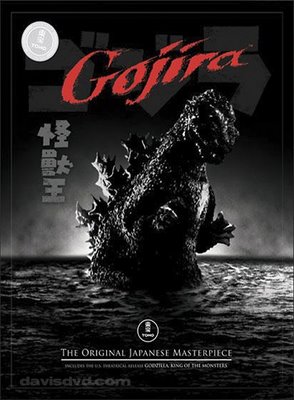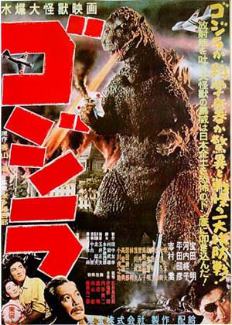
from Kolchak:
Nearly everyone who’s seen a Godzilla movie knows that the Big G originated in Japan. However, the movie that actually introduced Godzilla has not been available in America until relatively recently.
I’m not talking about . Godzilla, King Of the Monsters. I’m talking about the original Japanese production, Gojira. “King Of Monsters” includes an hour’s worth of footage from the original, rearranged and re-edited to incorporate new scenes with Raymond Burr. However, a full-length version of Gojira had a short theatrical run in America in 2004 and it’s now part of a classy--and inexpensive--DVD boxed set with Godzilla, King Of the Monsters..
Even if you’ve seen other movies in this series, I think Gojira is going to surprise you.
According to the background material that comes with the DVDs, Gojira was born out of pure necessity. In early 1954, a major project for Toho studios in Japan fell through. In order to fill the hole in their production schedule, the studio heads decided to make a movie about a giant monster awakened by an atomic blast.
By itself, this idea was nothing special; American movie-goers had already been introduced to The Beast From 20,000 Fathoms. What makes,Gojira different is the way this basic idea is handled. In it’s own way, the movie is a sincere attempt to grapple with a world with the atomic bomb, just as films like United 93 attempt to come to terms with a world where America can be attacked by terrorists.
In the case of Gojira, though, the movie happens to include a man in a latex dinosaur suit.

Much of the credit for .Gojira’s tone can be given to director and co-scripter Ishiro Honda. The son of a Buddhist priest, Honda was drafted into the Japanese Imperial Army in 1936, and fought as foot soldier for eight years in occupied China. After Japan’s surrender, he saw the ruins of Hiroshima on his way home.
As Honda , who died in 1993, told one interviewer, “Most of the visual images I got were from my war experience. After the war, all of Japan, as well as Tokyo, was left in ashes. The atomic bomb had emerged and completely destroyed Hiroshima.
“If Godzilla had been a dinosaur or some other animal,” he said., “he would have been killed by just one cannonball. But if he were equal to an atomic bomb, we wouldn’t know what to do. So I took the characteristics of an atomic bomb and applied them to Godzilla.”
Honda came to Gojira,after directing documentaries for Toho, so the movie has a grainy, newsreel look that helps to establish the story’s realism. That can still be seen in “King Of Monsters,” though. There are some things that don’t make into the American version, or, if they do, it’s in a very altered form.
The original includes a scene where the members of a government committee argue over telling the public that the appearance of Godzilla is connected to atomic testing ( They finally decide to do so.)
During Godzilla’s rampage through Tokyo, there’s a touching scene where a mother tries to comfort her children by telling them that they’ll be with their father soon. In “King Of Monsters”, this scene is reduced to just a few seconds, with no dialogue.
In the same movie, after the oxygen destroyer kills Godzilla (apparently), Raymond Burr intones, “ The whole world could wake up and live again.” In the original, though, Dr. Yemane warns, “If we continue testing H-Bombs, another Godzilla will one day appear.”
(If you’re wondering why I’m using the name Godzilla, no matter which movie I’m referring to, it’s mostly a matter of convenience. However, in this DVD set, the subtitles in Gojira, do use the name Godzilla, despite the title of the movie. Honda’s quote also used Godzilla.)
In general, Gojira has a darker, more somber tone than its American cousin, and it’s filled with images of ruined cities and orphaned children, inspired by reports from Hiroshima and Nagasaki. In comparison, Burr tells the story of Godzilla, King of the Monsters as a flashback, which eliminates some of the tension immediately, since we can be fairly sure that Burr’s character survived the monster’s attack.
Still, I really don’t want to badmouth “King Of Monsters” here. It’s nobody’s classic, but it’s fun to watch. In addition, the scenes with Burr are integrated pretty well from a technical viewpoint, particularly when you consider that the filmmakers are doing it without the help of computers. It’s just a very different movie from Gojira.
***
It looks like it’s time for me to start earning my merit badge in self-promotion. I’ve got essays in two books of BenBella’s Smart Pop series which are now in stores. One is Star Wars On Trial , which also has contributions by David Brin and Mathew Woodring Stover. The other is Getting Lost , edited by Orson Scott Card.
The first book has a different format from most of the other Smart Pop entries. Pairs of writers debate different questions related to the Star Wars film. If you want to get a taste of what the book is like, check out the website at (surprise, surprise): www.starwarsontrial.com.
I also have a short story in Lance Star-Sky Ranger, a pulp-style anthology now available from Wild Cat Books. You can take a close look at the book at: www.lulu.com/wildcatbooks.
We return you now to your regularly scheduled blog.
No comments:
Post a Comment